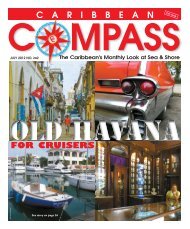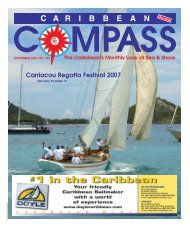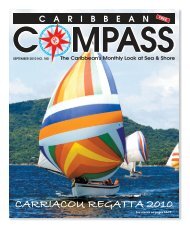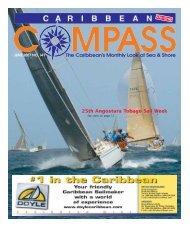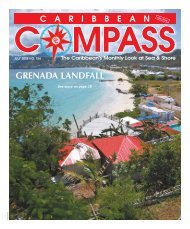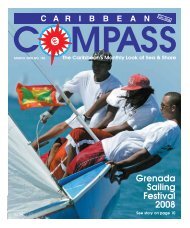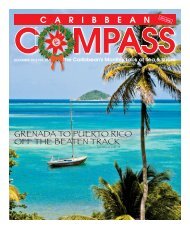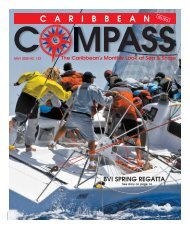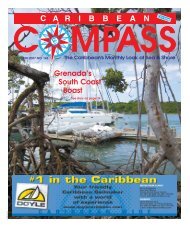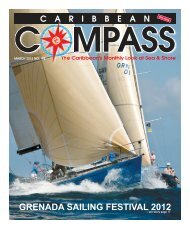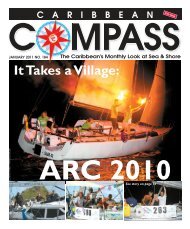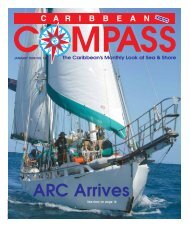Create successful ePaper yourself
Turn your PDF publications into a flip-book with our unique Google optimized e-Paper software.
— Continued from previous page<br />
The study documents in detail the declines of marine predators on <strong>Caribbean</strong> coral<br />
reefs that occur alongside human population growth, jeopardizing the region’s<br />
marine food web and ultimately its reefs and fisheries. Stallings found that nations<br />
with more people have reefs with fewer large fish because, as the number of people<br />
increases, so does demand for seafood — and bigger fish are usually fished first.<br />
Given that about half the world’s population lives near coastlines and that the<br />
world population is growing, demands for ocean-derived protein will continue to<br />
increase, Stallings warned. He said meeting such demands while retaining healthy<br />
coral reefs may require multiple strategies, including implementation of marine<br />
reserves, finding alternative sources of protein, and increased efforts to implement<br />
family-planning strategies in densely populated areas.<br />
Meanwhile, a marine ecologist who has studied some of the most pristine and<br />
untouched coral reefs in the world says there is a way to fight back against devastating<br />
deaths of coral reefs caused by climate change and warming oceans.<br />
Enric Sala, a former professor at Scripps Institution of Oceanography and now a<br />
National Geographic Fellow, said damaged coral will grow back if it is in a healthy<br />
environment with lots of predator fish. “This is not rocket science,” said Sala. “If we<br />
allow the fish to return, we can buy time and allow for something to be done about<br />
climate change.” Most of the coral in the <strong>Caribbean</strong> is badly degraded, he said. There<br />
are exceptions off Cuba, Belize, Costa Rica and Mexico. The way to bring back the reefs,<br />
he said, is to create marine reserves that allow for the restoration of predator fish.<br />
Reduce the fishing effort by half, take away fishing subsidies, create protected<br />
areas and fix climate change, Sala said. While it will take time to deal with climate<br />
change, he said the first three steps would buy that time.<br />
Venting<br />
According to an April report in BBC World News (http://news.bbc.co.uk/2/hi/<br />
science/nature/8611771.stm), what are believed to be the world’s deepest undersea<br />
volcanic vents have been discovered in the <strong>Caribbean</strong>. The vents, known as black<br />
smokers, are located 5,000 metres (3.1 miles) down in the Cayman Trough.<br />
The volcanic chimneys, which spew out water hot enough to melt lead, were caught<br />
on film by a British-led team. Marine biologist Dr. Jon Copley said: “Seeing the<br />
world’s deepest black-smoker vents looming out of the darkness was awe-inspiring.<br />
Super-heated water was gushing out of their two-storey-high mineral spires, more<br />
than three miles beneath the waves.”<br />
Expedition leader Doug Connelly said: “We hope our discovery will yield new<br />
insights into biogeochemically important elements in one of the most extreme naturally<br />
occurring environments on our planet.”<br />
The team, led by the UK National Oceanography Centre in Southampton, sailed<br />
across the <strong>Caribbean</strong> on the scientific research vessel the James Cook. The discovery<br />
was made with the help of two deep-sea vehicles. Firstly, a robotic submarine called<br />
Autosub6000 enabled the team to map the seafloor of the Cayman Trough in fine<br />
detail. Then a vehicle called HyBIS, equipped with high-definition cameras, was lowered<br />
and captured detailed images of the smokers.<br />
By studying life around the hydrothermal vent systems, which are dotted along the<br />
deep-sea mountain range that girdles the planet, the team hopes to increase the<br />
understanding of the way marine communities interact. This, in turn, could aid<br />
efforts to better protect endangered marine species. Senior researcher Dr. Alex<br />
Rogers, from the Zoological Society of London, said, “The densities of animals and<br />
the biomass of life around these hydrothermal vents is just staggering.”<br />
However, scientists will not have these extraordinary environments to themselves<br />
for long. Gold, silver, copper and zinc are all present in the mineral-rich emissions<br />
of the vent systems and recent advances in deep-sea oil exploration are giving miners<br />
the chance to exploit these areas for the first time. Dr. Copley is well aware of the<br />
moral and political questions being raised by the team’s groundbreaking work.<br />
He believes that we are at a crucial crossroads in the use of the deep ocean.<br />
He can see a future where nation states squabble over natural resources, but he<br />
is optimistic that the international co-operation demonstrated on his current voyage<br />
will lead to sensitive study and sustainable exploitation of the deep sea’s riches.<br />
“Hopefully there’s a different path forward if we’ve got the courage and determination<br />
to take it,” he told BBC.<br />
Adopt a Sea Turtle!<br />
In April, the Venezuelan environmental group Fundacion La Tortuga launched its<br />
“Adopt a Sea Turtle” campaign. The goal of the project, run in conjunction with the<br />
Grupo de Trabajo en Tortugas Marinas de Nueva Esparta, is to involve children,<br />
Fundación La Tortuga President Alberto Boscari says, ‘Five of the seven types of sea<br />
turtles in the world live in Venezuelan territory, so we can consider ourselves privileged’<br />
young people and adults in an interactive way to raise funds for environmental conservation<br />
activities, especially those involving the protection of sea turtles.<br />
Five of the Earth’s seven species of sea turtles are found in Venezuela. The symbolic<br />
“adoption” of a turtle will offer opportunities to participate in “turtle camps”,<br />
night watches to guard nesting areas, the release of hatchlings, turtle rescues, lectures,<br />
and sea-turtle monitoring and evaluation projects.<br />
For more information visit www.fundacionlatortuga.org/FLT/node?page=1<br />
—Continued on next page<br />
JULY 2010 CARIBBEAN COMPASS PAGE 11




